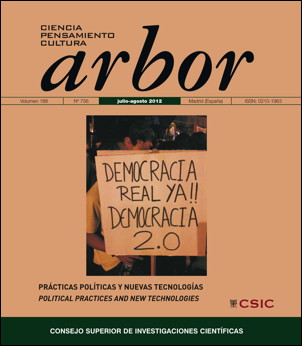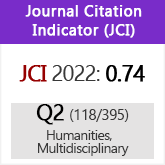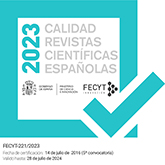Uso de los blogs políticos: análisis de algunos factores determinantes
DOI:
https://doi.org/10.3989/arbor.2012.756n4005Palabras clave:
Determinantes, blogs políticos, análisis factorial, usos de internet, brecha digitalResumen
Objetivo de este trabajo es avanzar en la comprensión de los determinantes que hacen que un internauta escriba comentarios en un blog político. Más en concreto, se ha decidido averiguar qué variables políticas influyen sobre este comportamiento y qué usos de Internet parecen favorecerlo. También se ha estudiado el efecto de algunas variables socio-demográficas de control. Para ello, se han utilizado los datos del estudio de 2007 “Internet y participación política” (ref. 2736) del Centro de Investigaciones Sociológicas. Se ha implementado un análisis factorial exploratorio y, en un segundo momento, una regresión logística. La muestra elegida para el análisis ha coincido con los internautas españoles, para así descartar influencias en el modelo debidas a la brecha digital de primer nivel.
Descargas
Citas
Anduiza, E.; Cantijoch, M.; Colombo, C.; Gallego, A. y Salcedo, J. (2010): “Los usos políticos de Internet en España”, Revista Española de Investigaciones Sociológicas, 129(–1), 133-146.
Attewell, P. (2001): “Comment: The first and second digital divides”, Sociology of education, 74(3), 252-259. http://dx.doi.org/10.2307/2673277
Bar-Ilan, J. (2005): “Information hub blogs”, Journal of Information Science, 31(4), 297. http://dx.doi.org/10.1177/0165551505054175
Best, S. y Krueger, B. (2005): “Analyzing the representativeness of Internet political participation”, Political Behavior, 27(2), 183-216. http://dx.doi.org/10.1007/s11109-005-3242-y
Bimber, B. y Davis, R. (2003): Campaigning online: The Internet in US elections, Oxford University Press, USA.
Bimber, B. (2001): “Information and political engagement in America: The search for effects of information technology at the individual level”, Political Research Quarterly, 54(1), 53.
Bonfadelli, H. (2002): “The Internet and knowledge gaps”, European Journal of communication, 17(1), 65. http://dx.doi.org/10.1177/0267323102017001607
Bruns, A. (2008): “Life beyond the public sphere: Towards a networked model for political deliberation”, Information Polity, 13(1), 71-85.
Cliff, N. (1988): “The eigenvalues-greaterthan-one rule and the reliability of components”, Psychological Bulletin, 103, 276-279. http://dx.doi.org/10.1037/0033-2909.103.2.276
Coleman, S. y Wright, S. (2008): “Political blogs and representative democracy”, Information Polity, 13(1), 1-6.
Coleman, S. (2004): “Connecting Parliament to the Public via the Internet”, Information, Communication & Society, 7(1), 1-22. http://dx.doi.org/10.1080/1369118042000208870
Coleman, S. (2005): “Blogs and the new politics of listening”, Political Quarterly, 76(2), 272-280. http://dx.doi.org/10.1111/j.1467-923X.2005.00679.x
Colombo, C. (2007): Innovación democrática y TIC ¿Hacia una democracia participativa?, Universitat Oberta de Catalunya.
Cornfield, M. (2000): “A user’s guide to the digital divide”, Campaigns and Elections, 21(3), 47.
Dahlberg, L. (2001): “Democracy via cyberspace”, new media & society, 3(2), 157.
De Zuniga, H. G.; Puig i Abril, E. y Rojas, H. (2009): “Weblogs, traditional sources online and political participation: an assessment of how the internet is changing the political environment”, New Media & Society, 11(4), 553. http://dx.doi.org/10.1177/1461444809102960
De Zuñiga, H.; Veenstra, A.; Vraga, E.; Wang, M.; DeShano, C.; Perlmutter, D. y Shah, D. (2007): “Online and Offline Activism: Communication Mediation and Political Messaging Among Blog Readers”, Annual convention of the Association for Education in Journalism and Mass Communication, Washington, DC, 9-12.
DiMaggio, P.; Hargittai, E.; Neuman, W. y Robinson, J. (2001): “Social implications of the Internet”, Annual review of sociology, 27, 307-336. http://dx.doi.org/10.1146/annurev.soc.27.1.307
Drezner, D. y Farrell, H. (2004): “Web of influence”, Foreign Policy, 32-41. http://dx.doi.org/10.2307/4152942
Dunham, R. (1999): “Across America, a troubling ‘digital divide’”, Business Week, 3640(2).
Eveland, W.; Hayes, A.; Shah, D. y Kwak, N. (2005): “Understanding the relationship between communication and political knowledge: A model comparison approach using panel data”, Political Communication, 22(4), 423-446. http://dx.doi.org/10.1080/10584600500311345
Ferguson, R. y Griffiths, B. (2006): “Thin democracy? Parliamentarians, citizens and the influence of blogging on political engagement”, Parliamentary Affairs, 59(2), 366. http://dx.doi.org/10.1093/pa/gsl006
Gibson, R. y Ward, S. (2002): “Virtual campaigning: Australian parties and the impact of the Internet”, Australian Journal of Political Science, 37(1), 99-129. http://dx.doi.org/10.1080/13603100220119047
Gibson, R.; Lusoli, W. y Ward, S. (2005): “Online Participation in the UK: Testing a ‘Contextualised’ Model of Internet Effects”, The British Journal of Politics & International Relations, 7(4), 561-583. http://dx.doi.org/10.1111/j.1467-856X.2005.00209.x
Gillmor, D. (2004): We the Media, O’Reilly Media, Inc.
Hacker, K. y Van Dijk, J. (2001): Digital democracy: Issues of theory and practice, Sage Publications, Inc. Thousand Oaks, CA, USA.
Hargittai, E. (2002): “Differences in people’s online skills”, First Monday, 7(4-1).
Harman, H. H. (1976): Modern factor analysis, Chicago: University of Chicago Press.
Hershey, M. y Hill, D. (1975): “Watergate and preadults’ attitudes toward the President”, American Journal of Political Science, 703-726. http://dx.doi.org/10.2307/2110723
Horrigan, J.; Garrett, K. y Resnick, P. (2004): The Internet and democratic debate, Pew Internet & American Life Project.
Hsu, C. y Lin, J. (2008): “Acceptance of blog usage: The roles of technology acceptance, social influence and knowledge sharing motivation”, Information & Management, 45(1), 65-74. http://dx.doi.org/10.1016/j.im.2007.11.001
Hwang, H.; Schmierbach, M.; Paek, H.; de Zúñiga, H. y Shah, D. (2006): “Media dissociation, Internet use, and antiwar political participation: A case study of political dissent and action against the war in Iraq”, Mass Communication and Society, 9(4), 461-483. http://dx.doi.org/10.1207/s15327825mcs0904_5
Jackson, N. (2008): “‘Scattergun’ or ‘rifle’ approach to communication: MPs in the blogosphere”, Information Polity, 13(1), 57-69.
Johnson, T. y Kaye, B. (2004): “Wag the blog: How reliance on traditional media and the Internet influence credibility perceptions of weblogs among blog users”, Journalism and Mass Communication Quarterly, 81, 622-642. http://dx.doi.org/10.1177/107769900408100310
Johnson, T.; Kaye, B.; Bichard, S. y Wong, W. (2007): “Every blog has its day: Politically-interested Internet users’ perceptions of blog credibility”, Journal of Computer-Mediated Communication, 13(1), 100-122. http://dx.doi.org/10.1111/j.1083-6101.2007.00388.x
Kahn, R. y Kellner, D. (2004): “New media and internet activism: from the ‘Battle of Seattle’ to blogging”, New Media & Society, 6(1), 87. http://dx.doi.org/10.1177/1461444804039908
Kaid, L.; McKinney, M. y Tedesco, J. (2007): “Political information efficacy and young voters”, American Behavioral Scientist, 50(9), 1093-1111. http://dx.doi.org/10.1177/0002764207300040
Krueger, B. (2002): “Assessing the potential of Internet political participation in the United States”, American Politics Research, 30(5), 476. http://dx.doi.org/10.1177/1532673X02030005002
Lawley, D. N. y Maxwell, A. E. (1971): Factor Analysis as a Statistical Method, 2nd edition. London: Butterworth.
Lewis-Beck, M. (1994): Factor analysis and related techniques, Sage London.
Livingstone, S. y Helsper, E. (2007): “Gradations in digital inclusion: children, young people and the digital divide”, New Media & Society, 9(4), 671. http://dx.doi.org/10.1177/1461444807080335
Margolis, M. y Resnick, D. (2000): Politics as usual: the cyberspace “revolution”, Sage.
Miller, A. (1974): “Political issues and trust in government: 1964-1970”, The American Political Science Review, 68(3), 951-972. http://dx.doi.org/10.2307/1959140
Mossberger, K.; Tolbert, C. y Stansbury, M. (2003): Virtual inequality: Beyond the digital divide, Georgetown Univ Pr.
Mutz, D.; Martin, P. (2001): “Facilitating communication across lines of political difference: The role of mass media”, American Political Science Review, 95(1), 97-114.
Nardi, B.; Schiano, D. y Gumbrecht, M. (2004): “Blogging as social activity, or, would you let 900 million people read your diary?” “Proceedings of the 2004 ACM conference on Computer supported cooperative work”, ACM, 222-231. http://dx.doi.org/10.1145/1031607.1031643
Norris, P. (2001): Digital divide: Civic engagement, information poverty, and the Internet worldwide, Cambridge Univ Pr. http://dx.doi.org/10.1017/CBO9781139164887
Norris, P. (2003): “Preaching to the Converted?”, Party Politics, 9(1), 21. http://dx.doi.org/10.1177/135406880391003
Robinson, J.; DiMaggio, P. y Hargittai, E. (2003): “New social survey perspectives on the digital divide”, It & Society, 1(5), 1-22.
Robles, J. (2008): Ciudadanía digital: una introducción a un nuevo concepto de ciudadano, Editorial UOC.
Schuefele, D. y Nisbet, M. (2002): “Being a Citizen Online: New Opportunities and Dead Ends”, The Harvard Journal of Press/Politics, 7(3), 55-75.
Shah, D.; Kwak, N. y Holbert, R. (2001): “‘Connecting’ and ‘disconnecting’ with civic life: Patterns of Internet use and the production of social capital”, Political Communication, 18(2), 141-162. http://dx.doi.org/10.1080/105846001750322952
Singer, J. (2005): “The political j-blogger”, Journalism, 6(2), 173. http://dx.doi.org/10.1177/1464884905051009
Subirats, J. (2002): “Los dilemas de una relación inevitable. Innovación democrática y tecnologías de la información y de la comunicación”, contenido en Cairo Carou, H. (Comp.), Democracia Digital. Límites y oportunidades, pp. 89-111, Madrid, Trotta.
Sweetser, K. y Lee Kaid, L. (2008): “Stealth soapboxes: political information efficacy, cynicism and uses of celebrity weblogs among readers”, New Media & Society, 10(1), 67. http://dx.doi.org/10.1177/1461444807085322
Wallsten, K. (2008): “Political blogs: Transmission belts, soapboxes, mobilizers, or conversation starters?”, Journal of Information Technology & Politics, 4(3), 19-40. http://dx.doi.org/10.1080/19331680801915033
Warschauer, M. (2003): “Demystifying the digital divide”, Scientific American, 289(2), 34-39. http://dx.doi.org/10.1038/scientificamerican0803-42 PMid:12884537
Wasserman, I. y Richmond-Abbott, M. (2005): “Gender and the Internet: Causes of Variation in Access, Level, and Scope of Use”, Social Science Quarterly, 86(1), 252-270. http://dx.doi.org/10.1111/j.0038-4941.2005.00301.x
Woodly, D. (2008): “New competencies in democratic communication? Blogs, agenda setting and political participation”, Public Choice, 134(1), 109-123. http://dx.doi.org/10.1007/s11127-007-9204-7
Wright, S. (2008): “Read My Day? Communication, campaigning and councillors’ blogs”, Information Polity, 13(1), 41-55.
Xenos, M. (2008): “New mediated deliberation: Blog and press coverage of the Alito nomination”, Journal of Computer-Mediated Communication, 13(2), 485-503. http://dx.doi.org/10.1111/j.1083-6101.2008.00406.x
Descargas
Publicado
Cómo citar
Número
Sección
Licencia
Derechos de autor 2012 Consejo Superior de Investigaciones Científicas (CSIC)

Esta obra está bajo una licencia internacional Creative Commons Atribución 4.0.
© CSIC. Los originales publicados en las ediciones impresa y electrónica de esta Revista son propiedad del Consejo Superior de Investigaciones Científicas, siendo necesario citar la procedencia en cualquier reproducción parcial o total.Salvo indicación contraria, todos los contenidos de la edición electrónica se distribuyen bajo una licencia de uso y distribución “Creative Commons Reconocimiento 4.0 Internacional ” (CC BY 4.0). Puede consultar desde aquí la versión informativa y el texto legal de la licencia. Esta circunstancia ha de hacerse constar expresamente de esta forma cuando sea necesario.
No se autoriza el depósito en repositorios, páginas web personales o similares de cualquier otra versión distinta a la publicada por el editor.















